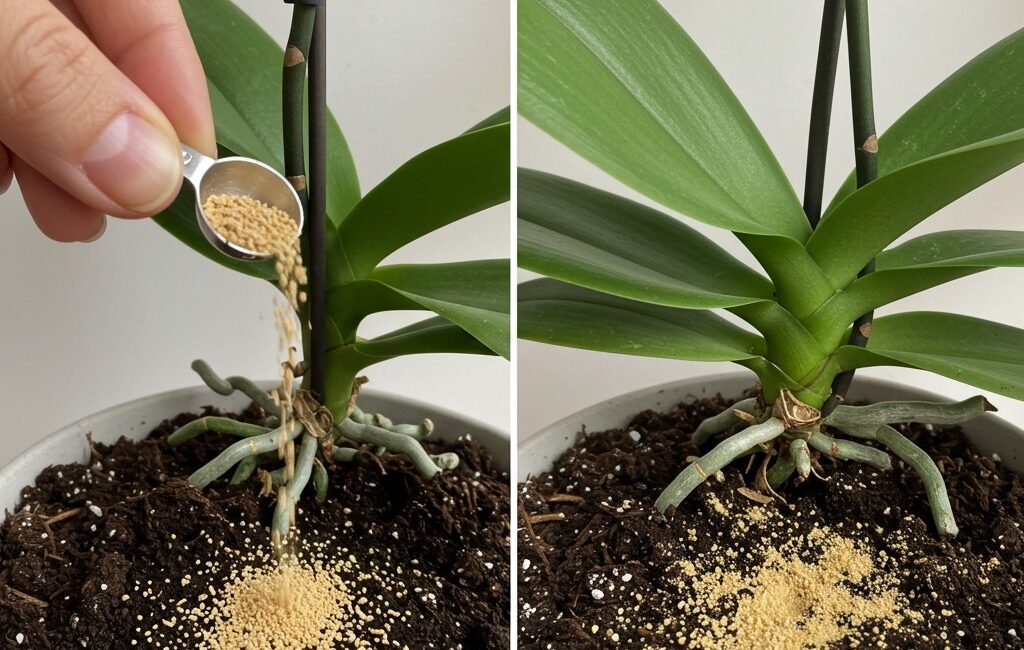Materials Needed
- Orchid plant in healthy condition (Phalaenopsis, Dendrobium, or any other species)
- Rooting hormone powder or solution OR organic fertilizer OR mycorrhizal inoculant OR homemade natural solution
- Measuring spoon (1 teaspoon)
- Water
- Spray bottle or small watering can
- Clean scissors or pruning shears (optional)
Instructions
- Prepare the Orchid for Treatment
- Check the orchid’s roots for any dead or rotten parts.
- Prune damaged roots carefully using sterilized scissors.
- Prepare the Solution
- If using rooting hormone powder, mix one teaspoon into a cup of warm water.
- For organic fertilizers, dissolve the teaspoon in water as per product instructions.
- If applying mycorrhizal inoculant, prepare according to label instructions.
- For homemade solutions, dilute accordingly (e.g., 1 tsp aloe vera gel in 1 cup water).
- Apply the Treatment
- Spray the mixture directly on the orchid roots and potting medium.
- Alternatively, lightly water the orchid with the solution.
- Avoid soaking to prevent root rot.
- Maintain Optimal Conditions
- Place the orchid in indirect bright light.
- Maintain humidity levels between 50-70%.
- Water sparingly but regularly.
- Avoid over-fertilizing during this period.
- Observe Root and Bloom Development
- New roots should appear within 2-4 weeks.
- Blooms may develop within the growing season.
- Repeat application monthly if needed.
The Science Behind Root Proliferation and Flower Abundance
How Hormones Affect Orchids
Auxins trigger the growth of lateral roots by activating gene expression related to cell division and elongation. When applied externally in controlled amounts, they mimic the plant’s natural hormones and stimulate massive root growth, explaining the “1001 roots” phenomenon.
Nutrient Impact on Flowering
Phosphorus promotes cell division and energy transfer, essential for flower development. Potassium regulates water balance and enzyme activity critical for blooming.
Fungal Symbiosis
Mycorrhizal fungi extend the root system’s effective surface area, allowing for better absorption of minerals and water, supporting vigorous growth and bloom production.
Common Mistakes to Avoid
- Overusing Rooting Hormones: Too much can burn roots.
- Poor Drainage: Orchids hate soggy roots.
- Inconsistent Watering: Causes stress, hindering bloom.
- Too Much Direct Sunlight: Leads to leaf burn.
- Ignoring Air Circulation: Orchids require good airflow.
Other Tips to Maximize Orchid Growth and Bloom
- Repot orchids every 1-2 years using fresh bark mix.
- Use balanced orchid fertilizers during growth phases.
- Provide 12-14 hours of light daily (using grow lights if indoors).
- Maintain stable temperatures (65-80°F) and humidity.
- Remove spent blooms to encourage reblooming.
Real-Life Success Stories
Many orchid enthusiasts report spectacular results after applying small amounts of rooting hormone or organic stimulants. They notice:
- Explosion of new root tips in weeks.
- Increase in flower spike number.
- Longer-lasting, larger flowers.
- Improved overall plant vigor.
FAQs
Can I use this method on all orchid types?
Most epiphytic orchids respond well, but terrestrial orchids may require adjusted care.
Is it safe to do this indoors?
Yes, but ensure good ventilation.
How often should I repeat the application?
Once a month during active growth seasons.
Conclusion
The secret to achieving a flourishing orchid with “1001 roots and abundant blooms” lies in understanding the plant’s biological needs and providing it with the right stimulus in precise amounts. Whether it’s a teaspoon of rooting hormone, a carefully prepared organic fertilizer, or a natural solution, this small but powerful application can transform your orchid into a thriving, blooming masterpiece.
With patience, care, and this simple technique, anyone can enjoy the rewarding beauty of orchids in full bloom, making your indoor garden or collection truly spectacular.




